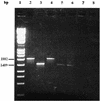Albidovulum inexpectatum gen. nov., sp. nov., a nonphotosynthetic and slightly thermophilic bacterium from a marine hot spring that is very closely related to members of the photosynthetic genus Rhodovulum
- PMID: 12200275
- PMCID: PMC124098
- DOI: 10.1128/AEM.68.9.4266-4273.2002
Albidovulum inexpectatum gen. nov., sp. nov., a nonphotosynthetic and slightly thermophilic bacterium from a marine hot spring that is very closely related to members of the photosynthetic genus Rhodovulum
Abstract
Several bacterial isolates, with an optimum growth temperature of about 50 degrees C, were recovered from the marine hot spring at Ferraria on the island of São Miguel in the Azores. The geothermal water emerged from a porous lava flow and rapidly cooled in contact with seawater except at low tide. The bacterial species represented by strains FRR-10(T) and FRR-11 was nonpigmented, strictly aerobic, and organotrophic. Several genes, bchZ, pufB, pufA, pufL, or pufM, encoding the photosynthetic reaction center proteins and the core light-harvesting complexes were not detected in these strains. The organism oxidized thiosulfate to sulfate with enhancement of growth. The organism did not require additional NaCl in the culture medium for growth, but NaCl at 1.0% enhanced growth. Phylogenetic analyses using the 16S rRNA gene sequence of strain FRR-10(T) indicated that the new organism represented a new species of the alpha-3 subclass of the Proteobacteria and that it branches within the species of the genus Rhodovulum. The contradiction of classifying an organism which branches within the radiation of the genus Rhodovulum but does not possess the hallmark characteristics of this genus is discussed. However, the absence of several of these characteristics, namely, the lack of photosynthesis and pigmentation, which could be related to colonization of dark environments, and growth at high temperatures, leads to our proposal that strains FRR-10(T) and FRR-11 should be classified as a new species of a novel genus, Albidovulum inexpectatum, representing, at present, the most thermophilic organism within the alpha-3 subclass of the Proteobacteria.
Figures





Similar articles
-
Rubritepida flocculans gen. nov., sp. nov., a new slightly thermophilic member of the alpha-1 subclass of the Proteobacteria.Syst Appl Microbiol. 2002 Aug;25(2):198-206. doi: 10.1078/0723-2020-00116. Syst Appl Microbiol. 2002. PMID: 12353873
-
Description of Labrenzia alexandrii gen. nov., sp. nov., a novel alphaproteobacterium containing bacteriochlorophyll a, and a proposal for reclassification of Stappia aggregata as Labrenzia aggregata comb. nov., of Stappia marina as Labrenzia marina comb. nov. and of Stappia alba as Labrenzia alba comb. nov., and emended descriptions of the genera Pannonibacter, Stappia and Roseibium, and of the species Roseibium denhamense and Roseibium hamelinense.Int J Syst Evol Microbiol. 2007 May;57(Pt 5):1095-1107. doi: 10.1099/ijs.0.64821-0. Int J Syst Evol Microbiol. 2007. PMID: 17473266
-
Albidovulum xiamenense sp. nov., a moderately thermophilic bacterium from a terrestrial hot spring.Int J Syst Evol Microbiol. 2012 Jul;62(Pt 7):1609-1612. doi: 10.1099/ijs.0.034454-0. Epub 2011 Sep 2. Int J Syst Evol Microbiol. 2012. PMID: 21890729
-
Truepera radiovictrix gen. nov., sp. nov., a new radiation resistant species and the proposal of Trueperaceae fam. nov.FEMS Microbiol Lett. 2005 Jun 15;247(2):161-9. doi: 10.1016/j.femsle.2005.05.002. FEMS Microbiol Lett. 2005. PMID: 15927420
-
Tepidicella xavieri gen. nov., sp. nov., a betaproteobacterium isolated from a hot spring runoff.Int J Syst Evol Microbiol. 2006 Apr;56(Pt 4):907-912. doi: 10.1099/ijs.0.64193-0. Int J Syst Evol Microbiol. 2006. PMID: 16585714
Cited by
-
Identification of archaea and some extremophilic bacteria using matrix-assisted laser desorption/ionization time-of-flight (MALDI-TOF) mass spectrometry.Extremophiles. 2004 Aug;8(4):259-68. doi: 10.1007/s00792-004-0382-7. Epub 2004 Mar 20. Extremophiles. 2004. PMID: 15042434
-
Effects of impurities on membrane-protein crystallization in different systems.Acta Crystallogr D Biol Crystallogr. 2009 Oct;65(Pt 10):1062-73. doi: 10.1107/S0907444909029163. Epub 2009 Sep 16. Acta Crystallogr D Biol Crystallogr. 2009. PMID: 19770503 Free PMC article.
-
Microbial community analysis of a coastal hot spring in Kagoshima, Japan, using molecular- and culture-based approaches.J Microbiol. 2013 Aug;51(4):413-22. doi: 10.1007/s12275-013-2419-z. Epub 2013 Aug 30. J Microbiol. 2013. PMID: 23990291
-
Isolation and partial characterization of a new moderate thermophilic Albidovulum sp. SLM16 with transaminase activity from Deception Island, Antarctica.Biol Res. 2019 Feb 4;52(1):5. doi: 10.1186/s40659-018-0210-7. Biol Res. 2019. PMID: 30717794 Free PMC article.
-
Urbanization Reduces Phyllosphere Microbial Network Complexity and Species Richness of Camphor Trees.Microorganisms. 2023 Jan 17;11(2):233. doi: 10.3390/microorganisms11020233. Microorganisms. 2023. PMID: 36838198 Free PMC article.
References
-
- Abraham, W.-R., C. Strömpl, H. Meyer, S. Lindholst, E. R. B. Moore, R. Christ, M. Vancanneyt, B. J. Tindall, A. Bennasar, J. Smit, and M. Tesar. 1999. Phylogeny and polyphasic taxonomy of Caulobacter species. Proposal of Maricaulis gen. nov. with Maricaulis maris (Polindexter) comb. nov. as the type species, and emended description of the genera Brevundimonas and Caulobacter. Int. J. Syst. Bacteriol. 49:1053-1073. - PubMed
-
- Blöchl, E., R. Rachel, S. Burggraf, D. Hafenbradl, H. W. Jannasch, and K. O. Stetter. 1997. Pyrolobus fumarii, gen. and sp. nov., represents a novel group of archaea, extending the upper temperature limit for life to 113°C. Extremophiles 1:14-21. - PubMed
-
- Cashion, P., M. A. Holder-Franklin, J. McCully, and M. Franklin. 1977. A rapid method for the base ratio determination of bacterial DNA. Anal. Biochem. 81:461-466. - PubMed
-
- Chung, A. P., F. A. Rainey, M. Valente, M. F. Nobre, and M. S. da Costa. 2000. Thermus igniterrae sp. nov. and Thermus antranikianii sp. nov., two new species from Iceland. Int. J. Syst. E vol. Microbiol. 50:209-217. - PubMed
-
- da Costa, M. S., M. F. Nobre, and F. Rainey. 2001. Genus I. Thermus, p. 404-414. In D. R. Boone and R. W. Castenholz (ed.), Bergey's manual of systematic bacteriology, vol. 1, 2nd ed. Springer-Verlag, New York, N.Y.
Publication types
MeSH terms
Substances
LinkOut - more resources
Full Text Sources
Molecular Biology Databases

